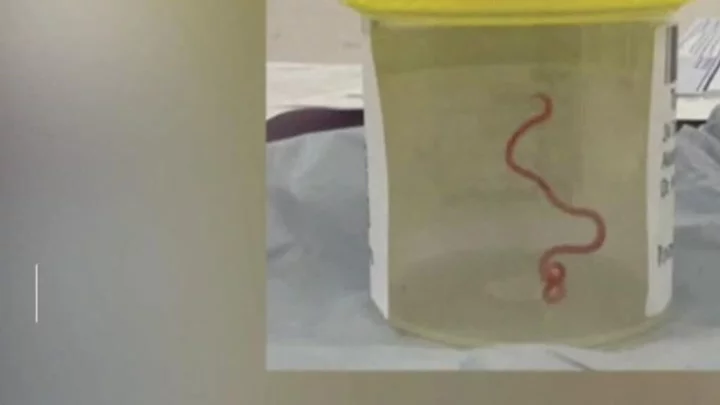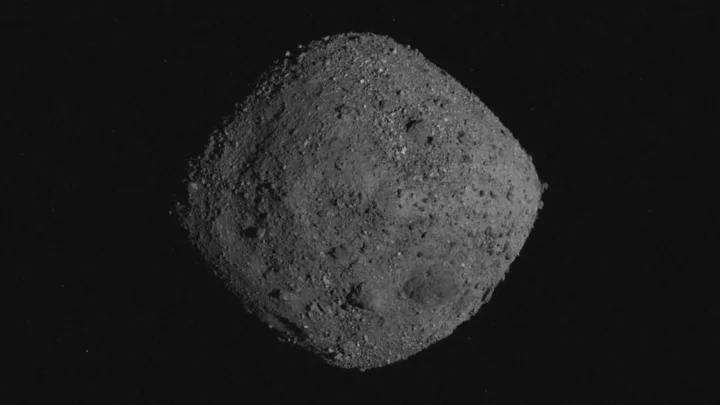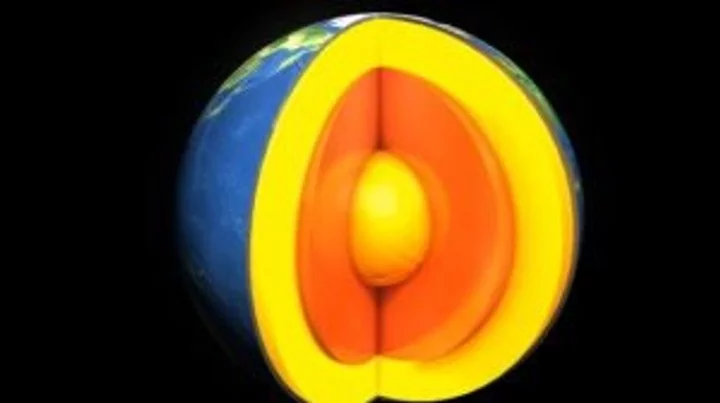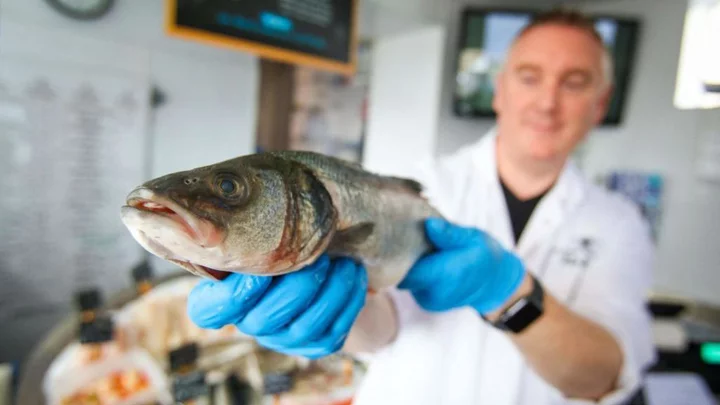
Pamela Anderson's makeup-free look draws praise from Jamie Lee Curtis
Pamela Anderson went without makeup for Paris Fashion Week and Jamie Lee Curtis found it beautiful.
2023-10-05 23:55

South Africa's Cyril Ramaphosa moves to tighten its porous borders
The new border force is designed to curb rising illegal immigration - a major political issue.
2023-10-05 23:46

Scientists solve 5-year mystery of tiny unidentified 'sea creature'
Scientists have got to the bottom of a 5-year mystery after finally identifying a tiny sea creature captured on camera in 2018. It is the latest in a series of oceanic discoveries and experts recently observed “zombie worms” devour an alligator in an incredible experiment. For the tiny creature, the baffling question of its identity took a team of zoologists and parasitic worm specialists to solve after the small creature was pictured by an underwater photographer in 2018 off the coast of Okinawa in Japan. After photographer Ryo Minemizu captured the image, he shared it on social media asking the hive mind if they knew what the creature was, but everyone was left stumped. Minemizu was determined not to give up and instead went back to the area and was able to capture another ladybird-sized creature that was the same, or very similar, to the original one he had come across. The research team that was interested in identifying the sea creature approached him and Minemizu sent them the sample to research. Your browser does not support the video tag. Current Biology (2023) The team’s results were published in the Current Biology journal putting an end to the 5-year long mystery baffling experts. In a fascinating twist, the team found that the sample was not one, but two creatures that were clinging tightly to one another. Both were identified as types of cercariae parasitic larvae worms, with experts dubbing one as the “sailor” and the other as a “passenger” thanks to how they behave when they are connected. Passengers were much smaller than the sailors and when they were bonded together, they formed a flat-topped hemisphere shape. They squeeze their bodies together with heads facing the inside of the sphere, meanwhile, their tails latch onto one another. Experts believe the two individual creatures have created a colonial organism that suits both of their needs and according to the study's authors, “represents the first case of labor division in digenean larvae”. Sign up to our free Indy100 weekly newsletter Have your say in our news democracy. Click the upvote icon at the top of the page to help raise this article through the indy100 rankings.
2023-10-05 23:26

Scientists weren't expecting what they found when they opened up the Bennu asteroid capsule
In late September, scientists at NASA and around the world eagerly awaited the arrival of the OSIRIS-REx capsule containing a sample of the asteroid Bennu. The capsule safely landed on Earth on Sunday 24 September in a Utah desert containing a sample of the asteroid Bennu – categorised as one of the two “most hazardous known asteroids”. When the capsule was first opened, it sparked audible gasps from scientists. Since its arrival, NASA has kept its cards fairly close to its chest but a new blog post from the space agency suggests that progress is going slowly for the “best reason” as there is more sample material than they had anticipated. They explained: “The abundance of material found when the science canister lid was removed earlier this week has meant that the process of disassembling the TAGSAM (Touch-and-Go Sample Acquisition Mechanism) head – which holds the bulk of material from the asteroid – is off to a methodical start.” The OSIRIS-REx’s mission took 7 years to complete, with the sample currently being analysed by NASA taken three years ago before making its way down to Earth. Imagery from the moment the sample was taken confirmed to scientists that there would be asteroid material where they found it, but the quantity of dark particles were far more than they had anticipated. “The very best ‘problem’ to have is that there is so much material, it’s taking longer than we expected to collect it,” said deputy OSIRIS-REx curation lead Christopher Snead of NASA’s Johnson Space Center. “There’s a lot of abundant material outside the TAGSAM head that’s interesting in its own right. It’s really spectacular to have all that material there.” In the coming weeks, experts will continue to work through the particles and begin the complex process of carefully disassembling the TAGSAM to reach the bulk of the Bennu sample inside. Sign up to our free Indy100 weekly newsletter Have your say in our news democracy. Click the upvote icon at the top of the page to help raise this article through the indy100 rankings.
2023-10-05 22:59

Conagra beats profit estimate as higher prices offset soft demand
By Granth Vanaik (Reuters) -Conagra Brands on Thursday reported quarterly profit above Wall Street estimates, as prices hikes and easing
2023-10-05 22:47

More than 1,350 lines of inquiry into Creeslough blast
Gardaí say they are continuing to investigate the fatal explosion one year on.
2023-10-05 21:50

Abkhazia: Russia to build naval base in Georgian separatist region, says local leader
The claim comes from the separatist region as Kyiv steps up attacks on Moscow's Black Sea fleet.
2023-10-05 20:25

How to talk to kids about cigarettes and vapes, following Rishi Sunak’s smoke-free generation plans
Stopping the nation from smoking has long been a top priority for medical experts, families and governments, and PM Rishi Sunak has made his plans for the issues clear. At the 2023 Conservative Party Conference, Sunak said that the legal age for buying tobacco should rise every year from those born in 2009 in a bid to “try and stop teenagers taking up cigarettes in the first place”. He said: “A 14-year-old today will never legally be sold a cigarette” under new legislation he is proposing for England. The Prime Minister also said more must be done to “restrict the availability” of vapes to children, but what can be done by parents in the meantime? Here are the conversations to have with your children… The dangers of smoking “Starting smoking and vaping at a young age can have serious and long-lasting health consequences,” explains Dr Chun Tang, medical director and GP at Pall Mall Medical. “Nicotine is particularly harmful to developing brains. Young people are more vulnerable to nicotine addiction, which can lead to a lifetime of tobacco dependence. Nicotine impacts cognitive function and memory, potentially affecting academic performance. “Aside from the detrimental effect on cognitive ability as outlined above, smoking is, of course, a leading cause of various health problems, including lung cancer, heart disease, stroke, chronic obstructive pulmonary disease (COPD), and many others,” he says. “Smoking during adolescence can also interfere with the growth and development of the lungs, leading to reduced lung function. This can result in breathing difficulties and decreased physical performance.” The dangers of vaping Vaping isn’t a safe alternative, yet he sweet-smelling, plastic steam machines are rife. “Vaping is a relatively new phenomenon, and the long-term health effects are still not fully understood,” says Tang. “There is ongoing research to assess the potential long-term risks, including the development of chronic health conditions.” Vaping has been associated with various adverse health effects, including lung injuries, respiratory problems, and cardiovascular issues, he notes. “Some of the chemicals found in vaping aerosols can be harmful when inhaled into the lungs. “If a smoker takes approximately 15 puffs of a cigarette before putting it out, then we can safely assume that a 600-puff disposable vape is equivalent to around two packs of cigarettes. “Some reports suggest young people can get through as many as 7 vapes a week, the equivalent of 14 packets of cigarettes. “That is an enormous amount of nicotine and so we can expect to see the health risks posed by nicotine to be [more] exacerbated in vapers than smokers – which could be severely impacting cognitive function and affecting academic performance.” It’s essential, he says, for parents, educators, and healthcare professionals “to educate young people about the potential risks of vaping and smoking and provide support and resources for those who want to quit”. Don’t lecture them Try to be open and curious rather than defensive and angry if your child is smoking or vaping. Dr Kerry Irving, senior clinical psychologist at online mental health platform Kooth, says: “Approach any conversation to understand why the young person smokes or vapes rather than to lecture, as the latter can cause people to shut down.” Consider available supportThere may be resources online and in person that might help your child, from the NHS to TikTok creators tracking their quitting journey. “Suggest accessing external support – encourage the young person to see their GP or to make use of some of the free Stop Smoking initiatives online or in your local community,” Irving says. Be sympathetic to relapse Expect wobbles. If your teen or child is quitting smoking or vaping try to stop accept that overcoming an addiction is not easy and recovery is not linear. “Relapses are an important part of changing any behaviour long term,” says Irving. “You can help the young person learn from these by gently encouraging them to reflect on what went wrong and helping them plan for how to try again.” Read More Charity boss speaks out over ‘traumatic’ encounter with royal aide Ukraine war’s heaviest fight rages in east - follow live 4 must-have denim trends for autumn, from wide-leg jeans to split skirts Doorscaping: How to create a fabulous front door display for autumn More than a quarter of middle-aged women living with ‘metabolically healthy obesity’ – study
2023-10-05 19:46

Assassin's Creed Mirage: Why Arabic is at the heart of the new game
The makers of the latest in the stealth action series have put Arabic front and centre of the project.
2023-10-05 19:22

Scientists shed surprising new light on the Earth's 'butter-like' inner core
For centuries we’ve been told that the Moon is made of cheese but now, it turns out, the Earth is more like butter. Or, at least, its inner core is. A new study led by experts at the University of Texas (UT) and collaborators in China found that iron atoms at the very centre of our world move around much more than previously thought, and the implications could be huge. Scientists have long sought to dissect the insides of our planet but it isn’t easy, given that we have no way of directly exploring its core. The deepest hole humans have ever dug – branded the "entrance to hell" – extended an impressive 12,263m (40,230ft) down, but even that doesn’t come close to breaking through the crust to the layers beneath. Still, thanks to techniques like seismic tomography – which analyses how waves of energy travel through different materials during earthquakes – we’ve been able to map out the world’s interior. Now, researchers have used lab experiments and AI algorithms to shed a striking new light on the heart of the planet. "Seismologists have found that the centre of the Earth, called the inner core, is surprisingly soft, kind of like how butter is soft in your kitchen," Youjun Zhang, a Sichuan University professor who co-led the investigation, said in a statement shared with Phys.org. "The big discovery that we've found is that solid iron becomes surprisingly soft deep inside the Earth because its atoms can move much more than we ever imagined. This increased movement makes the inner core less rigid, weaker against shear forces." The findings are significant because they could help explain the role that the inner core plays in generating the world’s magnetic field. They could also help us understand a number of the inner core’s key properties, which have long flummoxed experts. "Now, we know about the fundamental mechanism that will help us with understanding the dynamic processes and evolution of the Earth's inner core," Jung-Fu Lin, one of the study's lead authors, explained. Given that it is impossible for scientists to directly extract specimens from the inner core, Lin and his colleagues recreated it in miniature. They took a small iron plate, shot it with a fast-moving projectile, and collected the resulting temperature, pressure and velocity data, which they then fed into an AI computer model. Using this machine learning system, they were able to scale up the sample iron atoms configuration to mimic the atomic environment within the inner core. At this beefed-up scale, the researchers observed groups of atoms moving about while still maintaining their overall structure. Inner Core iron atom motion model University of Texas This movement could explain why seismic measurements of the inner core reveal an environment that's softer and more malleable than would be expected at such pressures, Prof Zhang explained. Around half of the energy that goes into generating the Earth's magnetic field can be attributed to the inner core, with the rest coming from the outer core, according to the UT team. Thanks to Zhang, Lin and their colleagues, we now have a clearer understanding of the inner core’s machinations at an atomic level, which could help inform how energy and heat are generated at the heart of the planet. This could also shed light on how the inner and outer core work together to generate the Earth’s magnetic field – a key ingredient in making a planet habitable. Sign up for our free Indy100 weekly newsletter Have your say in our news democracy. Click the upvote icon at the top of the page to help raise this article through the indy100 rankings.
2023-10-05 19:17

Bobi Wine 'under house arrest' after return to Uganda
Police deny opposition leader's claims he was grabbed by 'goons' on landing
2023-10-05 18:57

Donegal fishing businesses get €12m from Irish government
The Irish fishing industry was one of the main losers from the EU’s Brexit deal with the UK.
2023-10-05 18:25
